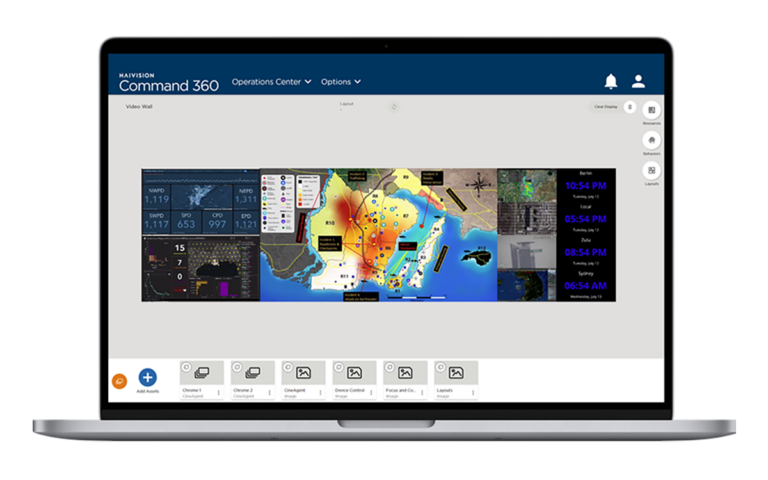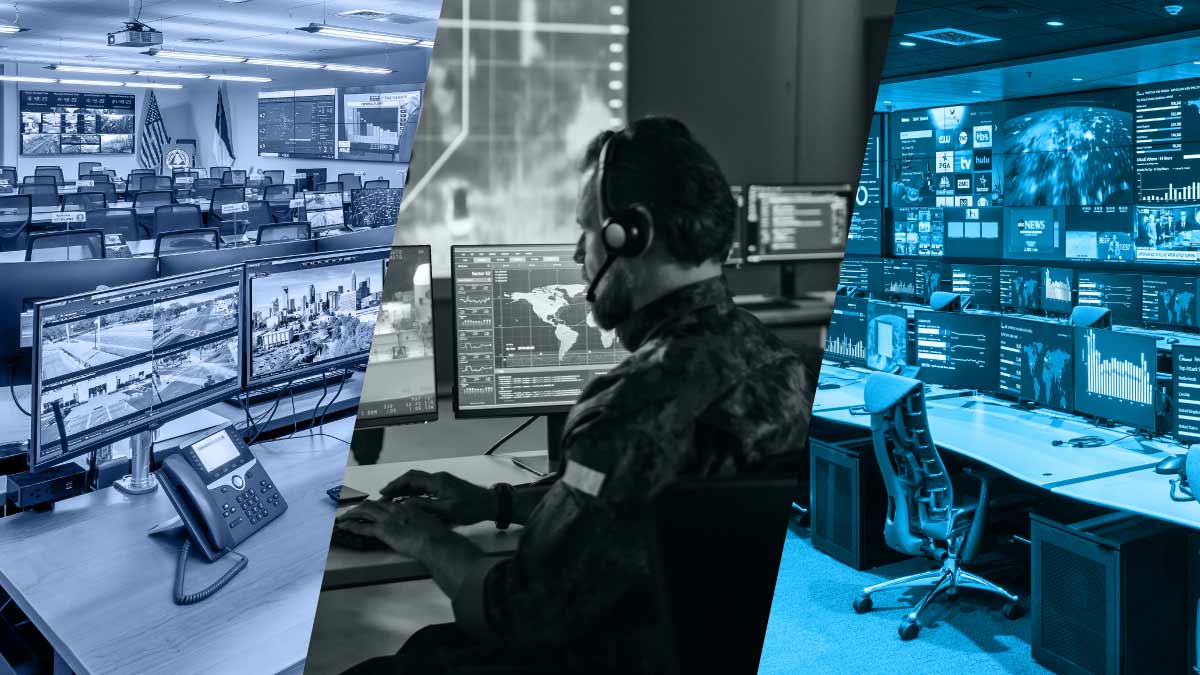Today’s operation centers, whether it be a cybersecurity operations center (CSOC), network operations center (NOC), real-time crime center (RTCC), tactical operations center (TOC) or any other type of control room, are reliant on cutting-edge technologies to capture meaningful insights from available data.
Operation centers can face many common challenges: data overload, demand for real-time information, security, and reliability are all concerns that require thoughtful technology choices.
The technology that supports a NOC is likely to differ from the technology required in an RTCC, a TOC, or a CSOC. It’s important to customize solutions that meet the specific needs of the center and your team, but that also integrate with your existing infrastructure.
Exploring Operation Center Rooms: A Tech Overview
Now, let’s dive into a deeper discussion on the technology specific to each kind of operation center:
Cybersecurity Operation Center (CSOC)
Security operation rooms (SOCs) are dedicated to ensuring the safety and security of physical and digital assets. Cybersecurity operations centers (CSOCs) (like Legato Security’s CSOC, for example) are dedicated to continuously monitoring and analyzing an organization’s security stance. Entities of various sizes utilize CSOCs to defend against cyber threats. CSOCs are commonly used by major IT firms, cybersecurity organizations, and financial institutions to protect their physical and digital assets and their clients’ assets.
Technologies in a CSOC include:
- Intrusion Detection Systems: In combination with the above access control systems, sensors and alarms play a role to detect unauthorized entry.
- Communication Systems: Often crucial to real-time decision-making and quick coordination is the use of communication systems, including intercoms, radios, and telephony systems.
- Incident Management Software: These tools are important for logging, managing, and responding to security incidents.
- Video Wall Displays: Enable simultaneous monitoring of multiple feeds and data points on large, multi-screen displays.
- Network Monitoring: Monitoring software allows a clear, dynamic picture of an organization’s security. This allows operators to ensure the security of digital assets and detect cyber threats.
- Ticketing System: Facilitates the efficient reporting and prioritization of threats, ensuring security incidents are managed and resolved based on their severity and impact.
- News and Weather Content: Integrates real-time news and weather information, enabling proactive adjustments to security measures and strategies in response to environmental and global events.
- Security Information and Event Management (SIEM): A critical tool for real-time security event monitoring, analysis, and reporting, enhancing the detection, investigation, and response to cyber threats.
Network Operation Room (NOC)
NOCs focus on monitoring and managing network systems and telecommunications. NOCs exist to safeguard the stability and integrity of an organization’s network infrastructure, particularly for telecom companies and large enterprises with extensive IT systems. For instance, international logistics giant Maersk relies on a NOC to guarantee seamless services and uninterrupted operations for millions of customers.
Technologies in a NOC include:
- Network Monitoring Tools: This includes software designed to monitor network health, traffic, and performance in real time.
- Server Management: The health of the organization’s networks is foundational to operations. As such, tools for managing and monitoring the status of servers and data centers are key in a NOC.
- Firewall and Security Appliances: These tools protect the network from cyber threats.
- Patch Management Software: These are tools that support patch management initiatives, such as updates to software, drivers, firmware, and other system components to protect against vulnerabilities and ensure optimal system performance.
- Data Visualization Dashboards: With data overload as a real challenge in operation centers, the ability to visualize information effectively is paramount. These dashboards offer real-time visualization of network status and analytics.
- Video Wall Displays: Empower comprehensive monitoring by presenting diverse feeds and data points concurrently through expansive multi-screen displays.
- Troubleshooting Tools: This includes software to diagnose and address network issues.
- Security Information and Event Management (SIEM): Essential for network operations centers (NOCs) to monitor, analyze, and manage network performance and security events in real-time. SIEM tools aid in identifying, investigating, and mitigating network anomalies and threats, ensuring optimal network reliability and performance.
Real-Time Crime Center (RTCC)
RTCCs are most often used by law enforcement agencies and metropolitan police departments, such as Cobb County, which leverages its RTCC to enhance both community and officer safety.
Technologies in an RTCC include:
- Real-Time Data Feeds: This is a broad category that is comprised of content sources such as various sensors, license plate readers, gunshot detection software, CCTV, and more. These tools allow for immediate analysis and action.
- GIS Mapping Tools: GIS mapping tools are used to visualize and manage geographical information in real-time. With these tools, crime center operators can put crime-related information on a map, helping them to visualize crime events in the context of the broader community.
- Emergency Dispatch Software: A critical technology in an RTCC are tools that allow for effective emergency response coordination, communication, and, ultimately, the dispatch of resources.
- Public Address Systems: This technology is used for real-time communication within the community in case of emergencies.
- Video Wall Displays: These large, multi-screen displays allow for monitoring various feeds and data points simultaneously.
- Intelligence-Led Policing Software: Enhances situational awareness and operational efficiency by integrating data from sources like Fusus, ShotSpotter, and CompStat. Facilitates real-time data sharing, pattern recognition, and resource management.
- News and Weather: Critical for real-time adjustments in operational strategies, incorporating weather forecasts and current news to ensure public safety and optimize law enforcement response to environmental and societal shifts.
- Social Media: A vital tool for early incident detection, evidence gathering, and community engagement, leveraging platforms like Twitter and Facebook to monitor trends, threats, and public sentiment.
Tactical Operations Center (TOC)
Tactical operations centers are mission-critical hubs designed for real-time coordination, situational awareness, and decision-making during active operations. Often supporting emergency response, military missions, or public safety efforts, TOCs bring together personnel, data, and communication systems in one secure environment to maintain operational control in high-stakes scenarios. For example, an emergency management team might rely on a TOC to coordinate multi-agency response during a natural disaster or large-scale public event.
Technologies in a TOC include:
- Real-Time Monitoring Tools: These provide a continuous feed of mission-critical information, including personnel tracking, sensor inputs, and incident alerts, ensuring teams maintain full situational awareness.
- Geospatial Mapping and Intelligence Platforms: Tactical teams often rely on live maps with overlaid intel to understand terrain, threat locations, and unit positioning.
- Secure Communication Systems: Encrypted voice, video, and data channels allow teams to coordinate without compromising operational security.
- Threat Detection and Incident Management Software: These platforms help identify, assess, and respond to potential threats quickly, often integrating multiple data streams into a single view for clarity and speed.
- Integrated Video Wall Displays: Large-format displays are central to TOCs, enabling staff to visualize live drone feeds, surveillance video, GIS data, and sensor alerts simultaneously for rapid, informed decisions.
- Sensor and Device Integration Platforms: From bodycams and UAVs to perimeter security systems, TOCs use technology that unifies inputs into one command interface.
- Data Visualization Dashboards: Simplifying complex data through real-time dashboards empowers operators to focus on anomalies and key performance indicators without distraction.
- Decision Support Systems: These systems synthesize incoming data to recommend courses of action, helping leaders respond quickly and effectively.
- Access Control and Cybersecurity Solutions: With sensitive data and critical systems on display, TOCs must integrate strong physical and digital security protocols, including identity verification and network protection.
Tactical operations centers thrive on speed, clarity, and adaptability—qualities enhanced by technologies like Haivision’s Command 360, which brings together disparate sources of mission-critical information into a centralized management platform.
Each type of control room is equipped with technology tailored to its specific operational needs, ranging from cybersecurity and network management to tactical operations and real-time control. Here, we’ve only covered a handful of operation center types, and a broad overview of the technology commonly found within each environment. For a more in-depth exploration into the technology commonly found in all centers, check out our blog.
Solutions For All Operation Centers
Solutions such as Haivision Command 360 play a pivotal role in optimizing the capabilities of operation centers across various industries, enabling efficient collaboration, faster decision-making, and heightened situational awareness. However, the variation in technology is endless! You’ll find that every room’s technology stack is different and reflects the unique challenges and objectives of each control room’s domain, that’s why it’s best to get started with an expert today!


